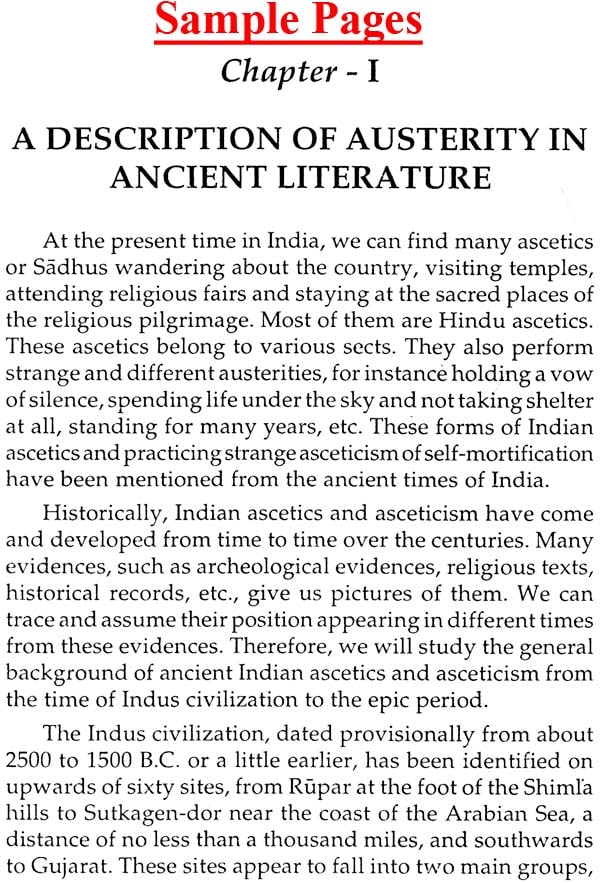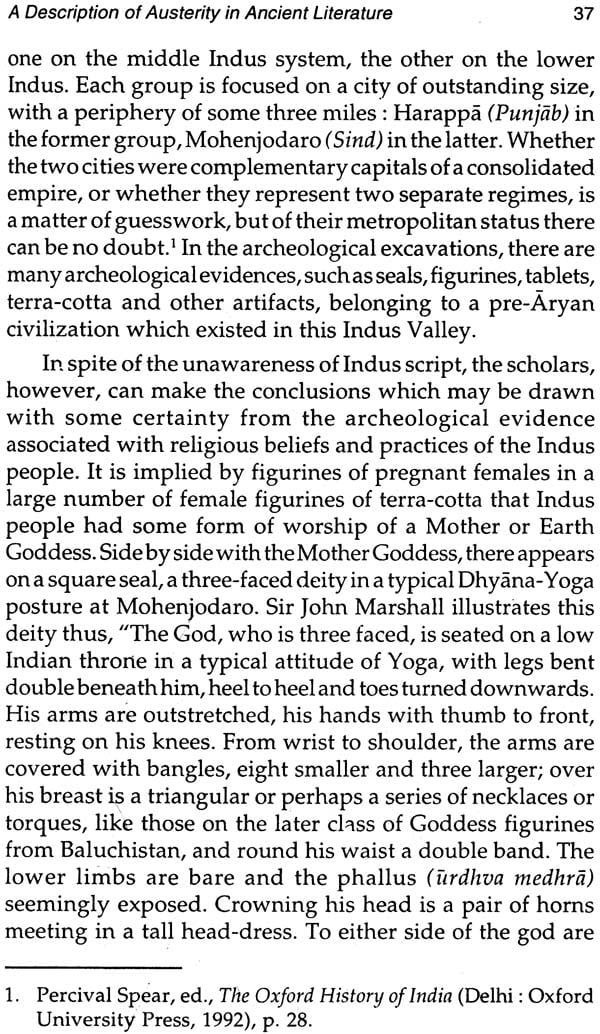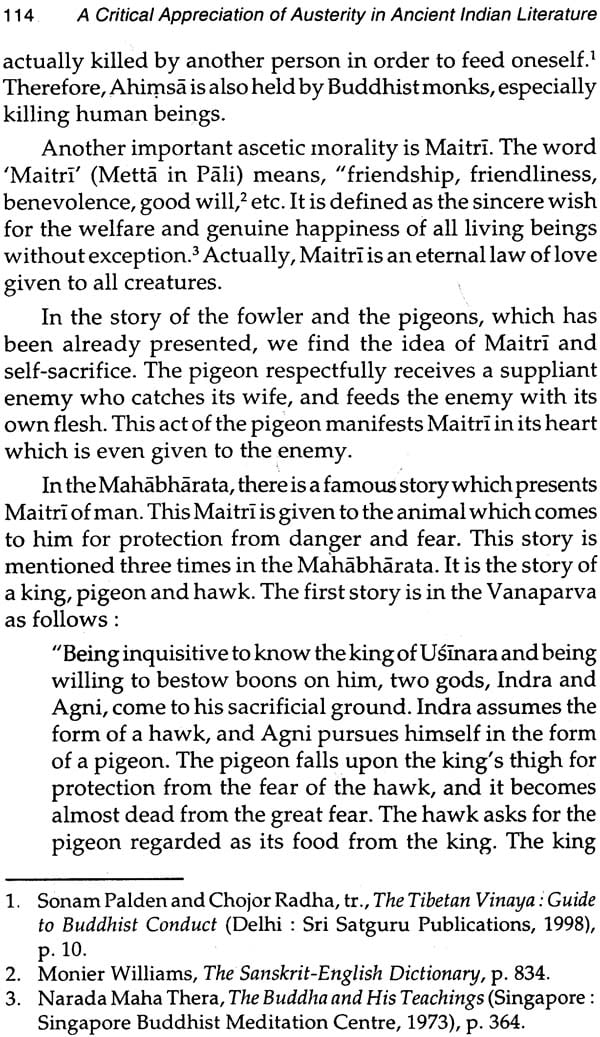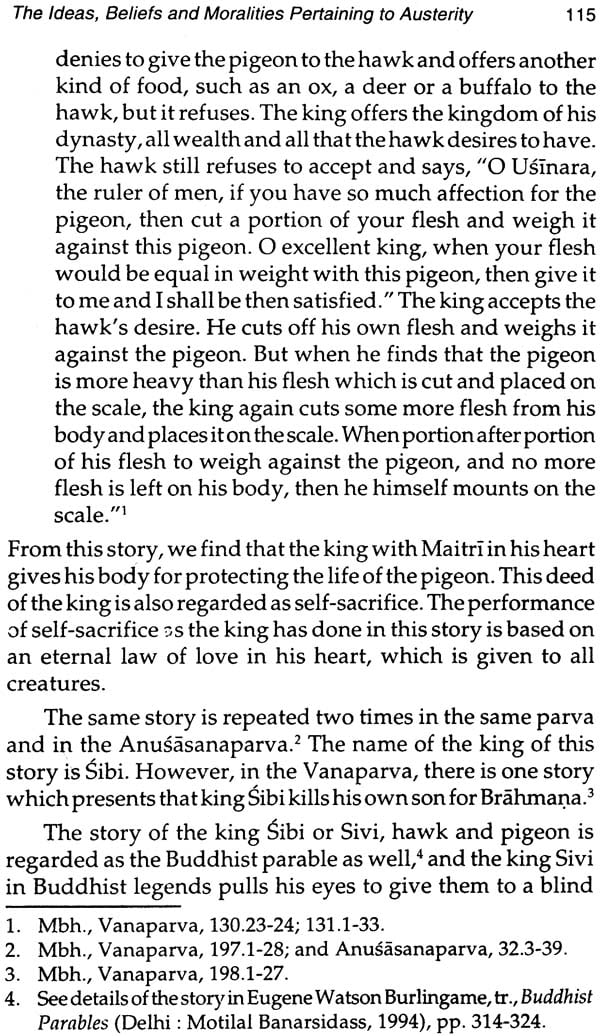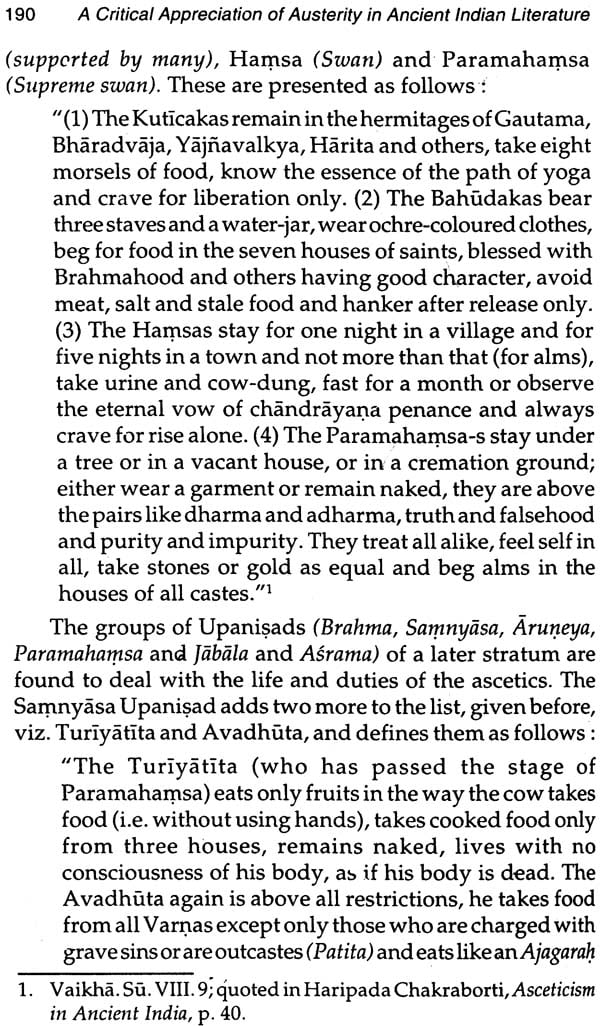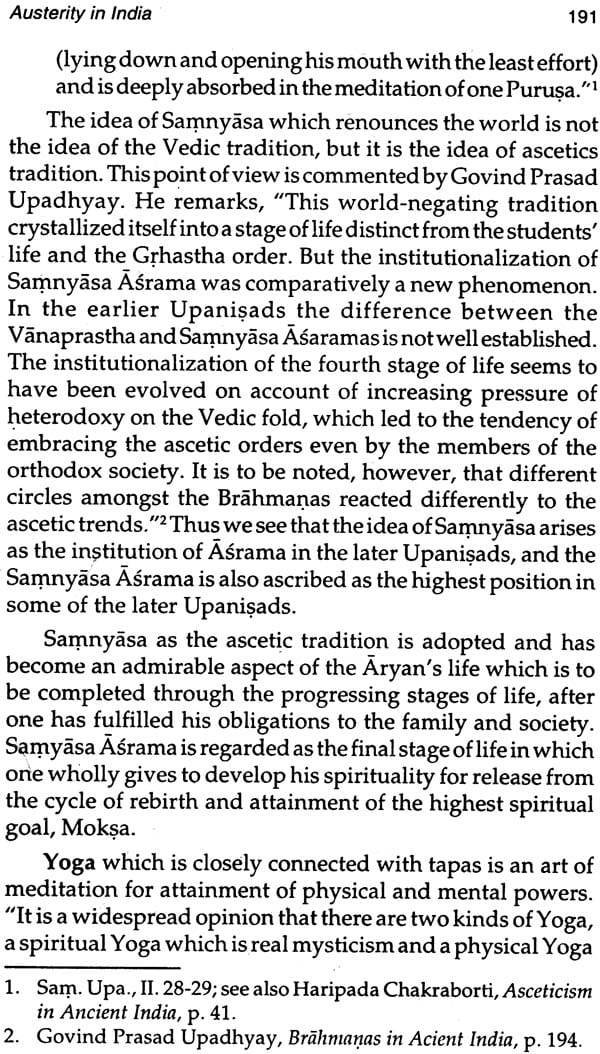
A Critical Appreciation of Austerity in Ancient Indian Literature
Book Specification
| Item Code: | NAO535 |
| Author: | Yajanveer Dahiya |
| Publisher: | Eastern Book Linkers |
| Language: | English |
| Edition: | 2003 |
| ISBN: | 8178540320 |
| Pages: | 256 |
| Cover: | Hardcover |
| Other Details | 8.5 inch x 5.5 inch |
| Weight | 390 gm |
Book Description
The book A critical appreciation of austerity in ancient Indian Literature presents a fundamental requirement of human nature, and it is a discipline by which human beings can attain the spiritual idea or the highest spiritual aim. The saints train their minds and bodies in their life. Among all countries of the world, India is regarded as one of the sources of culture and civilization. She gives her heritage, such as religion, philosophy, literature, art, etc., which flows down from an ancient time to people at present time. Her great ancient wisdom leads people to be enlightened in their minds. Austerity is one of the most important factor of Indian culture.
Austerity consists of various aspects, such as ancient ideas, beliefs, practices, etc., However, the concept of austerity can be divided into four dimensions, viz. Tapas, Vairagya, sarnyasa and Yoga. Tapas is mentioned in Vedic Literature and other religious texts. From their study, we find that the idea of tapas has developed and changed from time to time continuously. Tapas has two aspects-negative and positive. Self-mortification, Self-torture or self-denial are regarded assthe negative aspects of tapas. Self-control, self-discipline or self-training are regarded as the 'positive aspect. Vairagya is an attitude of genuine dispassion and freedom from worldly desires. It is the essential means for attainment of wisdom. The idea of Vairagya leads to withdrawal from worldly life. Then it is regarded as the foundation of Samnyas life. Sainyasa is renunciation of the world or an abandonment of all worldly bonds, such as family, wealth, etc. One who is in Samnyasa stage gives up all worldly ties, desires, and he devotes himself to develop his spirituality for release from the cycle of rebirth and for obtainment of the highest spiritual aim, Moksa., Yoga is regarded as an art of meditation. It is closely related with tapas and performed for achieving physical and mental powers. In the previous time, Yoga was a means for attaining supernatural power. It was developed to become a system of Philosophy and a technique of spiritual enlightenment in the later time. So in the development of austerity in India, We find that these four dimensions increase their importance from time to time till they become and specific forms of processes and disciplines of Indian asceticism.
From this study, we conclude that in ancient Indian Literature, there were two different currents of principal ideas, that is Brahmanical idea and ascetic idea. Therefore, the newly developed religion at that time, such as Jainism and Buddhism, also contain the ascetic idea or asceticism. In the course of time, the Brahmanism absorbs the ascetic idea in its development. Though the Brahmanism is developed to the Hinduism in the later time, yet the ascetic ideas or asceticism still plays an important role in Hinduism as well as in Jainism and Buddhism, Indian life and Society till the modern time.
Dr. Yajan Veer Dahiya (Formerely Prof. and Head, Department of Dayanand Studies Chair and Director, Institute of Sanskrit and Indological Studies Kurukshetra University, Kurukshetra) is an eminent Sanskrit scholar and Indologist. At present he is a Professor and Head, Department of Sanskrit, Pali and Prakrit and Ex Dean, Faculty of Humanities, M.D. University, Rohtak.
Dr. Dahiya belongs to Dahiya Gotra which came from Maharshi Dadhici. In linguistic process -dh changes into h and final semi vowel i changes into y i.e. (Dadhici-Dadhica-Dahiya). Therefore, in due course of time it became Dahiya. This Gotra belongs to Saraswati (Goddess of learning). Once she happened to be wife of Dadhica due to curse of Durvasa, although she was a daughter of Brahma.
In medieval, India for the protection of the country, the Dahiyas fought against the invaders and therefore, they are popularly known as Dahiya-Badshchas new-a-days. Since then they became Khatriyas.
Dr. Dahiya was born in 1949 in the Jat family of warriors and wrestlers of National fame (of village Rohna, District Sonipat, Haryana) for which Panini has recorded a dhatu (root) in the Dhatupatha, 4th century B.C. or earlier e.g. Jar Samghate (war, battle, killing etc. MWD). Again Panini recorded a word Yaudheya in his Astadhyayai in a number of times and in the contemporary Sanskrit Literature we find a term Ayudhajivindh (those who depend on war) for the same.
In, his childhood, Dr. Dahiya joined the Gurukul Jhajjar, (Paninian School of Grammar) studied there for a number of years and did Shastri and Vyakaranacarya. After that he studied at Kurukshetra University doing B.A. (Honours in English). Dr. Dahiya did his M.A. in 1973, Ph.D. in 1977 from Panjab University, Chandigarh and D. Litt., from Garhwal University, Srinagar in 1989. He Served as a lecture at Panjab University, Chandigarh for two years. By this time, Department of Sanskrit was started at Maharshi Dayanand University, Rohtak, he joined the Department as its founder in 1978 and since then he was on the staff of Maharshi Dayanand University, Rohtak. In 1990 he joined the Kurukshetra University, Kuruksherta as Professor & Head, Department of Dayanand Studies, Chair & Director Institute of Sanskrit & Indological Studies. Again, he joined the Department of Sanskrit, M.D. University, Rohtak as Professor.
Apart from the book in hand, "The language of the Atharva-Veda", "Panini as Linguist : Ideas and Patterns", "Sanskrit Vyakarana IG Ruperekha, "Treatment of Phonology in Dayanand and Sanskrit Bhasa Darganam," Hinduism and Buddhism in perspective are published. More than seventy research papers have already been published in leading journals. He is a keen Participant at All India Oriental Conferences, Linguistic Conferences and world Sanskrit Conferences etc. He is fully conversant in Ancient and modern technique of learning.
Indian civilization and culture is full of the stories of the seers who had supernatural powers and could do many wonderful things, namely disappearing at will, cursing the others, and flying through the sky, etc. and who practised difficult penance for obtaining the supernatural powers, such as staying in the water in the cold season, sitting in the midst of four fires, standing on one leg, etc. Since childhood my mind was under the impression of those stories and pictures of the seers.
Therefore, I decided to do research work on the Austerity in the Ancient Indian literature. From my research work, I came to know that austerity is not only a means for attaining the supernatural powers but it is a means for leading a tranquility of human mind also. Moreover, austerity is a direct way guiding human beings to Unite with the Supreme Being or Ultimate Reaility. Austerity is an expression of the human nature to realise the highest spiritual goal. Therefore, a recluse is not only one who wants to attain the supernatural powers but also one who wants to realise peace of his mind and eternal happiness by training his own mind and body through the practices of self-mortification.
There is no doubt, the austerity has originated very early in India. From Indus civilization to the Mahabharata period, austerity, reclusory ideas and beliefs have continuously developed and come through the ages till the modern era. Indian ascetics are not strange men but they are the main thinkers and the leaders of a spiritual life. Their ideas and beliefs teach us to understand our life and this world in reality. Their moralities lead our life to higher and better existences. In the world today, if the people hold only two moralities, i.e. non-violence and friendship, they can live together with peace. The wars will not take place anywhere in the world, and weapons will not be made to destroy the human beings and the other creatures.
When people completely give up all violence from their minds, words and thoughts, and always have love for others, this world will go to an age of welfare for all creatures. I have had occasions of studying the Ancient Indian literature at close quarters, both as a student and teacher and I can confidently say that I must have scored delights' and lived laborious days in order to produce a critical appreciation of Austerity in Ancient Indian literature, so accurate in detail, perspicuous in style and discriminating in its critical judgements. It will prove to be the most profitable for scholars.
Finally, I wish to express my personal thanks to my own family members i.e. wife Smt. Chander Mukhi, Son—Vishva Deva, Daughter—Kanupriya, Son-in-Law—Vivek and their son Keyur (NRI) for their good wishes rendered to me all the times.
India has been known as the origin of an ancient civilization, many religions and philosophical systems. In the past as well as in present times, Eastern and Western scholars have been interested in her culture, tradition, art, literature, religion and philosophy, etc., and have tried to understand her inheritance. Having studied her ancient wisdom, many famous scholars have given their opinions and expressions in their works. Many oft-quoted expressions of European scholars, which are worthy of mention about India, are written by M.G. Bhagat in his work as follows:
"Out of many others, most worthy of mention are Goethe, Schopenhauer, Rolland and Toynbee. Goethe is said to have danced with joy over the Gernan translation of the Saluntala by Kalidasa. Schopenhauer eloquently expressed his faith in the Upanishads : 'It has been the solace of my life; it will be the solace of my death.' Rolland, who interpreted Gandhi, Vivekananda and Ramakrishna Paramhamsa to the Western world said : 'If there is one place on the face of the earth where all the dreams of living men have found a home from the very earliest days when men began their dream of existence, it is India.' In very recent memory, Toynbee, as if to flatter us declared : 'In India there is an attitude towards life and an approach to the needs of the present situation in the world as a whole,' and exhorted her to go on giving the world Indian examples of the spiritual fight that makes man human." The opinions of these scholars very clearly present the importance and greatness of Indian culture and civilization.
In the great and perfect culture, asceticism is very significant for a man as a means to be used to control himself from the lower impelling force of human nature and to develop his spirituality to supreme goal. As Sri Aurobindo comments, "There can be no great and complete culture without some element of asceticism in it; for asceticism means the self-denial and self-conquest by which man represses his lower impulses and rises to greater heights of his nature."' In Indian culture, we can find that the element of asceticism has influenced the life of Indian people and played an important role from very earliest period.
About asceticism in India, Paul Deussen writes, "It is a tribute to the high metaphysical capacity of the Indian people, that the phenomenon of asceticism made its Appearance among them earlier and occupied a larger place than among any other known people."2 Therefore, asceticism and ascetic ideas have been affectionately upheld and continuously developed in India, and nowadays also ascetic practices are still performed. We can see that many forms of ascetic practices, such as non-speaking, standing, keeping the right arm up, fasting, panca-agni-tapasya, samadhi and Yoga-postures, etc., are still observed by Indian ascetics. Many ascetics have dwelt in dark caves or underground basements, and never seen the light of day. Many ascetics have followed the ascetic ideal of never living under a covering as prescribed in the Holy Scriptures. Some ascetics follow this performance in the modem time also.
Contents
| preface | vii | |
| Abbreviations | ix | |
| Introduction | 12785 | |
| I | A Description of Austerity in Ancient Literature | 36-74 |
| II | The Ideas, Beliefs and Moralities Pertaining to Austerity | 75-118 |
| III | Austerity in the Mahabharata | 119-167 |
| IV | Austerity in India | 168-210 |
| Summary | 211-216 | |
| Bibliography | 217-225 | |
| Some Concurrences | 226-231 | |
| Index | 232-244 |
